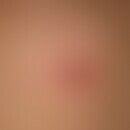Synonym(s)
DefinitionThis section has been translated automatically.
St. John's wort grows mainly along roadsides, on rough pastures and in bushes. It is characterized by yellow flowers growing in umbels. The glandular oil vessels in the flowers appear black due to the dark red hypericin they contain - the red color is revealed when the fresh flowers are crushed. St. John's wort flowers from the end of June until late summer. It is highly toxic to horses in hay and the flowering plants in the pasture are also feared by horse owners.
The dried flowering shoot tips, flowers, leaves and stems are used phytotherapeutically, see Hyperici herba.
St. John's wort contains hypericins (naphthodianthrones), hyperforin (phloroglucin derivative), flavonoids and biflavones.
St. John's wort or Hypericum perforatum L. is a plant from the Hypericeae family. Hypericum perforatum L. is the parent plant of the official preparation (DAC86) of Hyperici herbae, St. John's wort.
According to EB6, the flowers of Hypericum perforatum are the starting products for the officinal oleum Hyperici.
Ingredients of Hyperici herbae: The red pigment hypericin, an anthracene derivative, is found in the tissue gaps of the plant; furthermore: hyperforin, flavonoids, tannins (about 10%), essential oils (0.5-1%) with the terpenes(alpha-pinene, myrcene).
Pharmacodynamics (Effect)This section has been translated automatically.
Internal: St. John's wort has mood-lifting, antidepressant and antianxiety effects. Inhibition of synaptosomal uptake of serotonin, norepinephrine, GABA and glutamate. ß-Down regulation of 5 HAT2-UP regulation (histone acetyltransferase subtype).
External: The different forms of application have an anti-inflammatory effect. Application forms have anti-inflammatory, antioxidant, antibacterial and antiviral effects. The tannins contained have an astringent effect. Furthermore, the extract seems to have a stimulating effect in keratinocyte cultures. The different effects require further differentiated investigations.
You might also be interested in
IndicationThis section has been translated automatically.
HMPC monograph: Well-established use: Mild and moderate depression
ESCOP monograph: internal: dry extracts with ethanol (50-68%) mild depressive episodes; dry extracts with ethanol or methanol 80%: mild to moderate depressive episodes
Powder, dry extracts 4-7:1, ethanol 35%, various liquid extracts, tinctures and a fresh plant pressed juice: intermittent states of mental exhaustion. Powder: mild gastrointestinal complaints.
External: mild skin inflammations, small wounds.
Commission E-Monoraphie: Internal: Psychovegetative disorders, depressive moods, anxiety and/or nervous restlessness;
oily St. John's wort preparations: dyspeptic complaints; post-treatment of injuries, myalgia (muscle pain), 1st degree burns.
Internal: Depressive mood states, nervous restlessness or anxiety.
External:
- Dermatitis solaris: Oleum Hyperici (St. John's wort oil), also known as red oil, is used as a wound healing agent for 1st degree burns and dermatitis solaris.
- Atopic eczema: A positive, randomized, placebo-controlled, half-side comparison study is available on atopic eczema with a 1.5% cream application (Schempp 2003).
- Also as an oil or ointment for the care of chapped skin or old scars, torn muscles and bruises.
Complication(s)This section has been translated automatically.
Light-skinned people should avoid strong sunlight or solariums while taking the product. An increased sensitivity to light irradiation may occur. This can be further increased by the application of anticoagulants of the coumarin type . An increased photosensitivity can also occur with local application.
Dosage and method of useThis section has been translated automatically.
s. Package leaflet finished preparations!
Internal: Usual intake as tea, capsule, tablets drops or plant juice. Dosage: max 900 mg plant extract.
Tea preparation: Brew 1 ½ teaspoons of the herb with a cup of water, cover and steep for 10 minutes. Drink one cup in the morning and one in the evening. Use for several weeks if possible to obtain sufficient effect.
Externally: External use as St. John's wort oil (oleum hyperici); furthermore in ointment form.
Undesirable effectsThis section has been translated automatically.
Light sensitization especially by hypericin, in veterinary medicine known as hypericism. In human medicine, phototoxic reactions have been described, including pseudoporphyria.
InteractionsThis section has been translated automatically.
Hypericum dry extract induces the activity of CYP3A4, CYP2C9, CYP2C19 and P-glycoprotein.
Concomitant use of ciclosporin, tacrolimus for systemic use, amprenavir, indinavir and other protease inhibitors, irinotecan and warfarin is contraindicated-.
Caution with concomitant use of amitriptyline, fexofenadine, benzodiazepines, methadone, simvastatin, digoxin, finasteride! Reduction in plasma concentrations possible.
Reduction in plasma concentrations of oral contraceptives!
Control of possible interactions with required anaesthetics before elective surgery.
Caution: combination with antidepressants (e.g. sertraline, paroxetine, nefazodone), buspirone or with triptans.
ContraindicationThis section has been translated automatically.
Systemic: Children < 12 yrs. Known photosensitivity, severe depressive episodes, concomitant use of ciclosporin A, tacrolimus, etc., protease inhibitors in HIV treatment, imatinib, etc. cytostatics, antidepressants (see also use of coumarin-type anticoagulants).
Not recommended during pregnancy and lactation due to lack of data.
PreparationsThis section has been translated automatically.
Laif® 900 film-coated tablets,
Jarsin® Tabl. 300-750, St. John's wort-ratiopharm®, Rhoival® tea.
Externally: Bedan® as a cream, from the 6th month of life. According to the manufacturer, no increase in photosensitivity.
Arthrodynat® ointment, Befelka® oil, Buenoson® N ointment, Dolo-cyl® oil - muscle and joint oil, Kytta ointment®, Phönox Kalophön ointment
Note(s)This section has been translated automatically.
LiteratureThis section has been translated automatically.
- Apaydin EA et al.(2016) A systematic review of St. John's wort for major depressive disorder. Syst Rev 5:148.
- Becker LC et al. (2014) Amended safety assessment of Hypericum perforatum-derived ingredients as used in cosmetics. Int J Toxicol. 33(3 Suppl):5S-23S.
- Golsch S et al. (1997) Reversible increase of photosensitivity in the UVB range by St. John's wort extract preparations. Dermatologist 48: 249-252
- Huang LF et al (2014) Hypericin: chemical synthesis and biosynthesis. Chin J Nat Med 12:81-88.
- Reichling J et al. (2003) St. John's Wort (Hypericum perforatum L.)--multicompound preparations versus single substances. Forsch Komplementarmed Klass Naturheilkd 10(Suppl1): 28-32
- Saller R et al. (2003) St. John's Wort (Hypericum perforatum): a plurivalent raw material for traditional and modern therapies. Forsch Komplementarmed Klass Naturheilkd 10(Suppl1): 33-40
- Schempp CM et al. (2003) Randomized, placebo-controlled, double-blind, half-page trial Topical treatment of atopic dermatitis with Hypericum cream. A randomized, placebo-controlled, double-blind half-side comparison study. Dermatologist 54: 248-253
- Schulz V (2001) Incidence and clinical relevance of the interactions and side effects of Hypericum preparations. Phytomedicine 8:152-160.
- Wölfle U et al. (20149 Topical application of St. John's wort (Hypericum perforatum). Planta Med 80(2-3):109-120.
- https://www.ema.europa.eu/en/documents/herbal-monograph/final-community-herbal-monograph-hypericum-perforatum-l-herba-well-established-medicinal-use_en.pdf
- https://arzneipflanzenlexikon.info/johanniskraut.php
- https://pflanzen.fnr.de/industriepflanzen/arzneipflanzen/pflanzen-datenbank
- Blaschek W (2015) Wichtl tea drugs and phytopharmaceuticals. A handbook for practitioners. Wissenschaftliche Verlagsgesellschaft Munich. S 342-345






